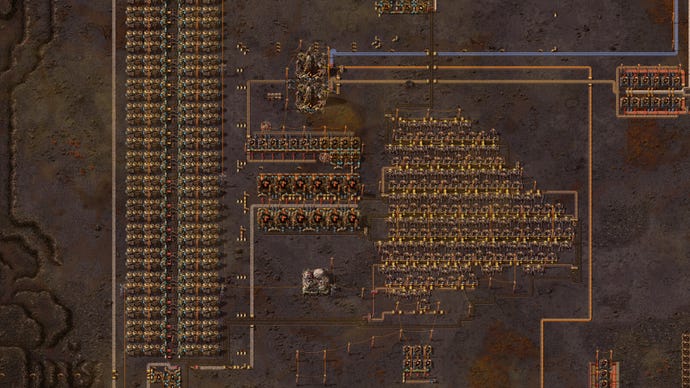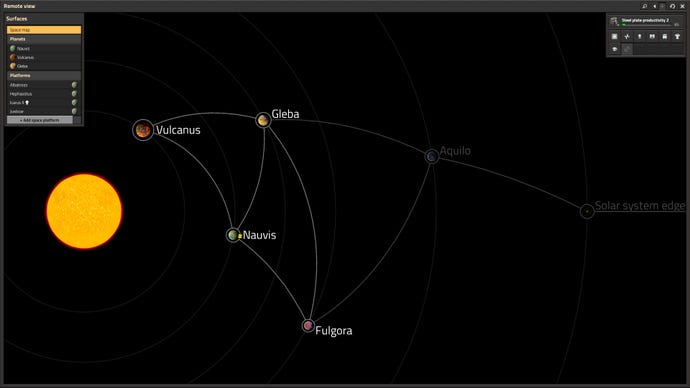To say that Factorio: Space Age throws out the rulebook is an understatement. It’d be more fitting to say it’s somehow automated the whole process: an inserter plucked out the rulebook from my brain and deposited it in hot magma, while a new rulebook was churned out in a nearby machine and plopped into my brain from the other side – only for that to be immediately plucked out and incinerated as well. With each new planet and each new phase, Space Age reinvents itself. I’m battling hyperbole here, but ah hell, I admit defeat. Factorio: Space Age is a masterpiece, the final form of perhaps the most well-crafted building game I’ll ever play.
Space Age seems entirely content with the first few hours, even the first few dozen, being pretty much exactly the same as it always was. Aside from a handful of quality of life changes, you basically just play a new game of Factorio. Punch rocks and trees. Place miners on iron and copper. Spin plates that keep everything manually fed until you have some boilers and steam engines up and running. Automate your first science packs. Research your first few techs so you can do everything again, but bigger and better. If you never clicked with Factorio before, Space Age is unlikely to change anything for you, because you’re unlikely to hang around long enough to see what Space Age truly has in store.
Me though, I’ve always been a factory game addict. I blasted through the first 40 automation-filled hours, and at last I reached the moment where the DLC truly began. In Space Age there are multiple new planets to explore, but first you need to construct ships capable of getting you there (and preferably back) in one piece. The moment I started to craft my first rocket, my production levels ground to a halt.
None of my previous knowledge helped me up there in alien territory. I had to slowly piece together how to send bits of foundation and other items up to my ship to start expanding it; how to place asteroid-grabbers on the perimeter and then filter the different asteroid types through specialised crushers to extract new resources like carbon and ice. How to then turn those into rocket fuel, and then automate ammo production for my gun turrets so I could blast apart large asteroid chunks before they turned my creation into a lonely, silent Hindenburg.
Like a pump placed exactly as far down the pipeline as needed to ensure throughput, Space Age came along at exactly the point in my playthrough where I might ordinarily have started to feel burnt out. Aboard my ship, it not only felt like starting a new game, it felt like learning Factorio all over again. Goodbye, efficiency and careful calculations. Greetings, endless bottlenecks, asteroid collisions, and staring at item descriptions without even a modicum of gorm. It sounds frustrating, but I loved every moment. If I ever got tired, I’d just chill out and watch the gorgeous animations on the spaceship. The foundations unfurling themselves bit by bit like chunky metal origami. The Doc Ock tentacles of the asteroid collectors, yoinking nearby chunks of metal and carbon out of space. The animations have always been stellar in Factorio, but the new buildings are works of art.
Eventually I got to my first new planet – Vulcanus. I jettisoned from my (thankfully still working) spaceship Hephaestus, and landed on a gorgeously hellish, lava-filled landscape. My inventory had to be completely empty to even start a journey through space, so when I landed on Vulcanus, I was starting from scratch. And the rulebook had once again been shredded.



Vulcanus feels truly different. Not just in the atmosphere and landscape, but the processes themselves. Familiar resources were present, but the ways I got hold of them were completely different. There were no iron or copper patches on the ground. Instead, I had to hit rocks to give me iron, copper, stone, and a new resource called Tungsten. Before I could do anything worthwhile, I needed a power source. But what to use? I was close to the sun, so solar power was a strong option, but I didn’t have the resources to build a single battery, and I didn’t fancy my entire factory switching off every evening. Steam power sounded good, but how could I get water for steam on a lava planet?
Turns out, all you need is some sulfuric acid, pumped in through geysers, and then you feed it into a chemical plant with a bit of a new resource called calcite, and that’s enough to get oodles of super-heated steam. You can then cool the steam to produce water, before feeding it into a familiar boiler and steam engine setup to produce steam at a lower, more useful temperature. Hey presto, you’ve got steam power on Vulcanus! And what a delightful process of discovery it was. Course, I realised later that night that I didn’t need to do any of that; all I needed was to pump the original super-heated steam into some turbines for huge amounts of energy. But hey, now I know for next time.
The whole purpose of going to Vulcanus is to produce the planet’s unique type of science pack: Metallurgic Science. Each planet has its own type of science which you need to automate if you want to research everything and get to the endgame. Gradually, I saw possibilities. I could pipe magma into the new Foundry building for an unlimited supply of iron and copper; I could use sulfuric acid to liquify coal into oil to make plastic for circuit boards; I could venture out into the fog of war to find some Tungsten deposits… Except that the landscape was crawling with colossal worms called demolishers which slaughtered me at a single touch and were almost impossible to kill. The first time I saw a (small) demolisher rumbling along the outskirts of my base, I actually laughed nervously at the screen.

At least the demolishers were passive. They’ll leave you alone unless you disturb their territory with buildings, or shoot them in the bum with a tank shell. Conversely, I soon discovered through repeated alerts that I’d perhaps left my home planet Nauvis a little hastily, as everything continues to run in realtime throughout the entire solar system no matter where you are. Up in orbit, my ship Hephaestus continued to be caressed by asteroids. And back on Nauvis, my turrets steadily ran out of ammo and were being destroyed by Biter attacks. I could see it all unfolding, but I couldn’t do anything about it until I found a way off-planet. That was a new kind of tension I hadn’t felt before in Factorio, and it was brilliant.
Thankfully some fast, focused work allowed me to cobble together a rocket and head back up to Hephaestus. 15 hours of worms and lava was enough to make Hephaestus feel quite nostalgic. It was a real moment of triumph. And then, a few minutes later, that same feeling was magnified as I returned to Nauvis, where I’d spend the next several hours shoring up defences, replacing depleted resource patches, and just generally making sure things would more adequately handle my next absence.

All the new interstellar systems and processes do remind me just how long it took to become even passably knowledgeable in Factorio. Space Age does nothing to help onboard new players and is as dense as ever. Probably much more so. Thankfully, the DLC does come alongside the free 2.0 update, which provides all players (of both Space Age and the base game itself) with a huge variety of quality of life improvements, as well as a couple of fundamental changes. There are new (far simpler and more satisfying) fluid dynamics, excellent new terrain generation, and a tonne of other tiny changes. Most of those changes would sound laughably inconsequential for non-addicts, but for automation husks like me, they’re music to my ears. And new features like the Factoriopedia and an excellent series of tips and tricks (complete with illustrative videos) available at a click do help to cut the learning curve and make things a bit more intuitive. None of that stops Factorio from being one of the most complex, confusing, consuming games I’ve played. With Space Age, the journey is longer and more mind-boggling than ever, but there’s also no better time to start.
All of Wube’s signature depth and engineering quality is present in nearly every part of Space Age. There’s a lightness of touch at work with all these new features and changes, a lessening of complexity in some areas and a heightening in others, all in the pursuit of fun and fascination. I sadly haven’t seen any of the other planets on offer besides Vulcanus, even after 100 hours in my save file. But several years of some of the most satisfying, addictive, cerebral fun I’ve ever had in a game has convinced me that Wube really know what they’re talking about. And from everything I’ve seen so far, Space Age is what Factorio was always meant to be.
Update: since writing this review I’ve started work on Gleba, and good lord, if I thought Vulcanus threw out the rulebook… You’re in for a treat here, folks.


